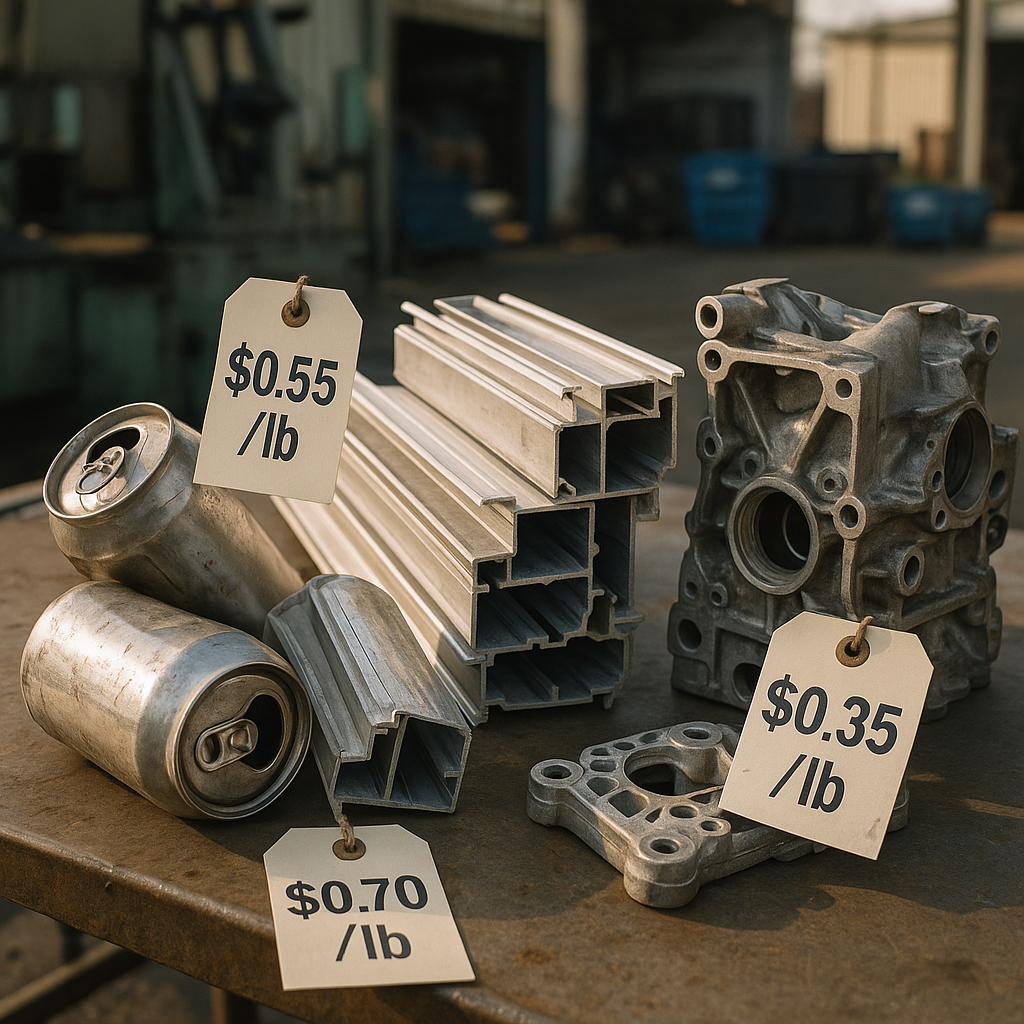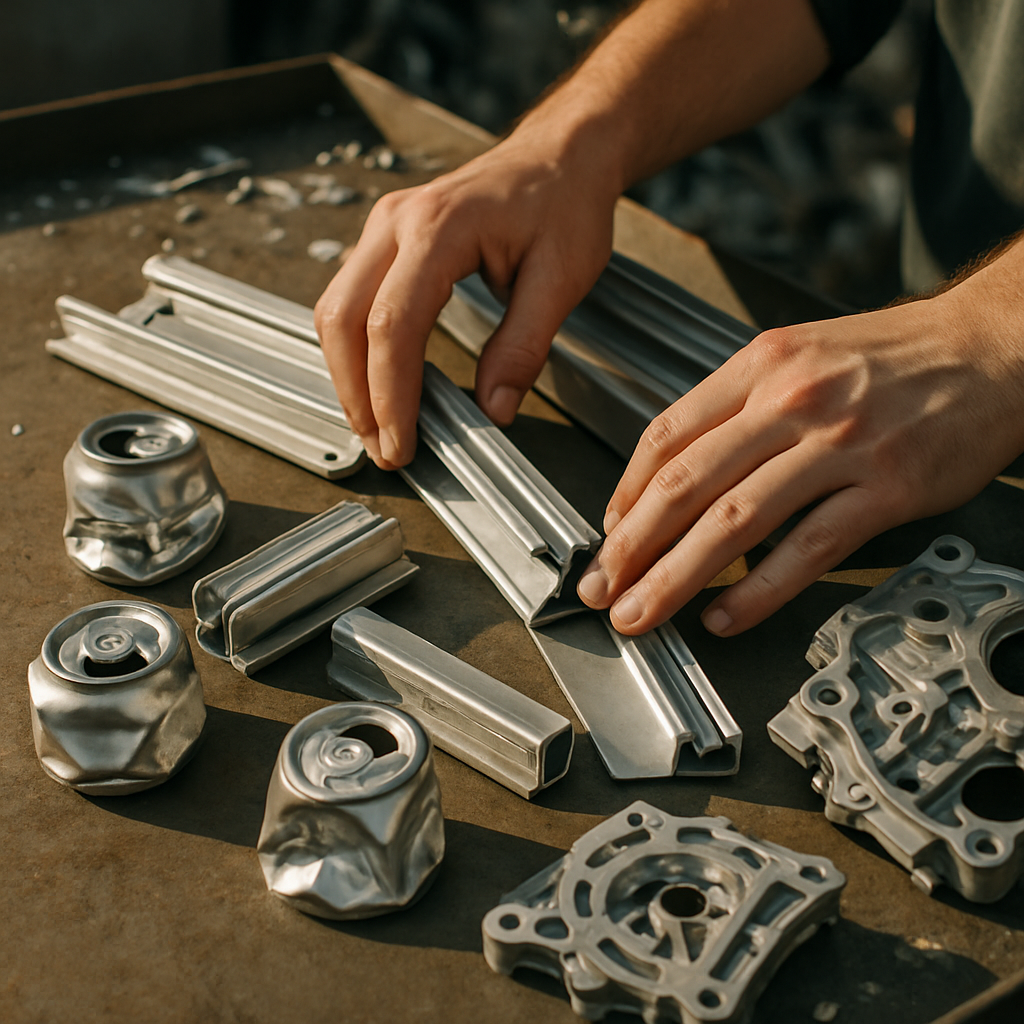5901 Botham Jean Blvd, Dallas, TX 75215
What is the Current Cost of Scrap Aluminum?
June 27, 2025Scrap aluminum currently trades between $0.35 and $0.50 per pound across the United States, with a national average of around $0.49 per pound. This makes aluminum recycling a consistently valuable option for both individuals and businesses. These prices apply to clean, sorted aluminum scrap without significant contamination.
Price variations are common in the recycling market. The specific grade of aluminum strongly influences its value, with clean extrusions and aluminum wheels typically fetching higher prices than mixed aluminum scrap. Regional factors also play a significant role, as urban recycling centers often offer better rates than rural facilities due to transportation costs and market competition.
Throughout 2023, market conditions continue to influence aluminum scrap values. The metal recycling industry responds to factors such as manufacturing demand, energy costs, and the global economy. For example, aluminum cans might fetch $0.40-0.45 per pound, while aluminum siding could command $0.46-0.51 per pound, depending on cleanliness and current market needs.
How Do Different Types of Aluminum Scrap Affect Pricing?

The value of aluminum scrap varies significantly based on its type, purity, and processing requirements. Different categories of aluminum scrap command distinct prices in the recycling market due to their unique properties and the amount of processing needed to reclaim usable aluminum.
Cast aluminum, one of the most common types in the recycling stream, typically sells for around $0.50 per pound. This price reflects its relatively high aluminum content while considering the presence of alloys that may require additional processing. In contrast, aluminum breakage, which contains more impurities and mixed materials, fetches less at approximately $0.18 per pound.
Aluminum cans are one of the most recognizable forms of recyclable aluminum and currently trade at about $0.38 per pound. Their standardized composition allows for easy processing, but since they are thin-walled, more cans are needed to accumulate substantial weight.
Price Variations by Aluminum Type
The pricing structure for aluminum scrap is directly tied to purity levels and processing needs. High-grade materials command premium prices because they require less refining before reuse. For example, aluminum rims from vehicles are particularly valuable, selling for approximately $1.00 per pound due to their solid construction and consistent alloy composition.
At the other end of the spectrum, aluminum thermopane, typically from window frames, contains additional materials like rubber seals and glass fragments. It sells for around $0.33 per pound because the extra separation work required lowers its market value.
Factors Influencing Aluminum Scrap Pricing
Key factors determine the final price offered for aluminum scrap. Purity is the most significant factor—the cleaner the aluminum, the higher the price. Contaminants like iron, rubber, plastic, or other metals significantly decrease value.
The form of the aluminum also matters. Extrusions and sheet aluminum typically fetch higher prices than cast aluminum due to their consistent composition. Market demand fluctuates based on manufacturing needs, with automotive and construction industries being major consumers of recycled aluminum.
Processing requirements also affect pricing. Materials requiring extensive sorting, cleaning, or separation steps before melting will command lower prices than ready-to-melt scrap. Regional factors play a role, with transportation costs affecting what recyclers can profitably pay for materials.
Maximizing Value When Recycling Aluminum
To secure the best prices when recycling aluminum, separate different types rather than mixing them. Clean aluminum free of non-metallic attachments will always command higher prices. For items like aluminum wire, removing insulation before recycling can substantially raise its value.
Quantity matters as well. Many recyclers offer better rates for larger volumes, so collecting a significant amount before selling can be advantageous. Staying informed about current market prices helps ensure fair compensation, as aluminum scrap prices fluctuate based on global market conditions.
Understanding these variations helps individuals and businesses maximize the value of their aluminum recycling efforts while contributing to the circular economy of this infinitely recyclable material.
Where Can I Sell My Scrap Aluminum?

Scrap yards are the primary locations for selling aluminum scrap, as they focus on purchasing various metals and typically offer better prices than standard recycling centers. Most scrap yards accept items ranging from aluminum cans to siding, gutters, and automotive parts.
Finding a local buyer is easier with digital tools like the iScrap App, which provides a yard locator service to help you find nearby scrap facilities. The app also shows recent price reports from other users, offering insight into current market rates.
Metal recycling centers are another option for selling aluminum scrap. They might offer slightly lower prices than dedicated scrap yards, but they often have more convenient locations and consistent operating hours. Some centers specialize in specific types of aluminum, potentially offering premium rates for certain grades.
Comparing prices is essential when selling scrap aluminum, as rates can vary significantly between facilities, even within the same city. Contact multiple yards to inquire about current pricing for your aluminum type. Some buyers adjust their prices based on quantity, cleanliness, and how well you’ve sorted your materials.
Keep in mind that market conditions influence aluminum prices daily. Many scrap yards now maintain websites or social media accounts where they post current rates. Checking these resources before loading your vehicle can prevent an unprofitable trip. Some facilities even offer price-match guarantees if you find a better-published rate locally.
When visiting a scrap yard, bring identification, as facilities need to record seller information to comply with local regulations. Prepare your aluminum by separating different grades and removing non-aluminum attachments to maximize your payout. Most scrap yards will weigh your materials upon arrival and pay you immediately in cash or check.
What Factors Influence Scrap Aluminum Prices?
Scrap aluminum prices are highly volatile and affected by a complex interplay of global and local economic forces. Understanding these factors can help you maximize returns when selling scrap aluminum.
Global Market Conditions
The global aluminum market significantly impacts scrap prices. LME (London Metal Exchange) pricing serves as a baseline for scrap aluminum valuations worldwide. When primary aluminum prices rise or fall on global exchanges, scrap prices typically follow suit.
International trade policies also play a crucial role in determining scrap aluminum values. Import/export restrictions, tariffs, and rebates can dramatically shift regional pricing. For instance, when China implemented stricter import policies for scrap materials, it created ripple effects throughout global scrap aluminum markets.
Currency fluctuations further complicate the pricing landscape. Since aluminum is traded internationally in US dollars, exchange rate movements can quickly alter the value of scrap in local markets.
Supply and Demand Dynamics
The fundamental economic principle of supply and demand remains a key price determinant. Demand for aluminum scrap varies with industrial output, particularly in automotive manufacturing, construction, and consumer goods production.
Seasonal factors also affect scrap aluminum prices. Construction activity typically increases during warmer months, boosting demand. Conversely, holiday periods often see reduced industrial activity, temporarily decreasing demand.
Scrap generation rates influence the supply side. Economic downturns generally reduce manufacturing activity, leading to decreased scrap generation. This can create counterintuitive price movements where reduced supply partially offsets reduced demand.
Regional and Local Factors
Transportation costs significantly impact local scrap prices. The weight-to-value ratio of aluminum means shipping expenses can quickly erode profit margins. Areas with numerous scrap processors typically offer more competitive prices due to local competition.
Energy costs affect both scrap processing and primary aluminum production. When energy prices spike, aluminum smelting becomes more expensive, potentially increasing the value of recycled aluminum as a cost-effective alternative.
Local environmental regulations and compliance requirements can also influence regional pricing. Stricter regulations may increase processing costs, affecting what scrap yards can pay for materials.
Material Quality and Processing Factors
The purity and quality of scrap aluminum directly impact its value. Clean, uncontaminated aluminum commands premium prices compared to mixed or contaminated materials. The alloy composition matters significantly—some alloys contain valuable elements that increase scrap value.
Processing requirements also affect pricing. Materials requiring minimal processing (like clean extrusions or sheet) typically receive higher prices than items needing extensive separation or decontamination.
The form factor matters too. Larger, uniform pieces are easier to process than small, irregular scraps. This efficiency difference is reflected in pricing, with prepared industrial scrap often valued higher than post-consumer materials.
Market Volatility and Timing
Scrap aluminum prices can fluctuate daily. These fluctuations reflect not just current conditions but market speculation about future supply and demand. Industry reports indicate that prices can shift by 5-10% within a single month.
Economic indicators and manufacturing data releases often trigger price movements. Announcements about automotive production, construction activity, or manufacturing indices can cause immediate pricing changes.
Inventory levels at LME-registered warehouses serve as important market signals. When inventories rise significantly, as they did in early 2024 when reaching their highest levels since January 2022, prices typically face downward pressure.
Conclusion: Maximizing Your Scrap Aluminum Value
To extract maximum value from your scrap aluminum, strategic planning and attention to detail are essential. By sorting your aluminum by type and grade, you can increase returns by 15-40% compared to selling mixed materials. Remove non-aluminum attachments like screws, plastic, or other metals to ensure you receive the highest grade classification. Clean aluminum fetches premium prices, making the effort to remove contaminants worthwhile.
Staying informed about market conditions is also crucial for maximizing profits. Monitor aluminum scrap prices through industry websites and build relationships with multiple buyers to secure the best rates. Consider timing your sales during construction season when demand typically rises. For consistent returns on your recycling efforts, contact Okon Recycling at 214-717-4083.
